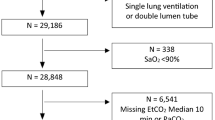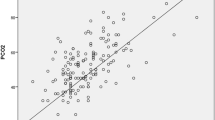Abstract
Intraoperative evaluation is deeply changed using many new tools, both invasive and non-invasive. Peripheral oxygen saturation percentage (SpO2) is the more reliable method for a non-invasive monitoring of patient’s blood oxygen concentration. Capnography (using end-tidal CO2 (EtCO2)) evaluation is an immediate and continuous non-invasive monitoring of carbon dioxide (CO2) in the breathing that provides important information on circulatory status and ventilation.
Aim of this study is to perform a preliminary analysis of oxygen change during surgery exploring its possible influence on post-operative evolution.
Methods and results: Intraoperative evaluation of SpO2 and EtCO2 was performed. Change in each parameter was categorised as 1 point for each five-point variation from baseline value (∆SpO2 as 1 point for each 5%, ∆EtCO2 as 1 point for each 5 mmHg). For each patient, the length of stay (LOS) in the intensive care unit (ICU), total hospitalisation, duration of intervention, surgical risk and complications were recorded.
Results: We analysed 93 consecutive patients (43 males and 40 females, aged 66.35 ± 9.79 years) that underwent peridiaphragmatic surgery. Forty patients (48.19%) presented complications after surgery. There was no statistically significant difference in age, duration of intervention and length of stay in ICU between complicated and non-complicated patients. As expected, patients with complications present an increased hospitalisation time compared to uncomplicated cases (14.69 ± 11.41 days vs 10.70 ± 6.28 days; p < 0.05). ∆EtCO2 was significantly increased (p < 0.05) in complicated compared to non-complicated. No differences were found in ∆SpO2 between the two groups. Considering the whole population, ∆EtCO2 presents a significant direct correlation to surgical risk, hospitalisation and duration of intervention.
Conclusion: ∆EtCO2 may be related to possible complications after surgery and hospitalisation. An important comparison between SpO2 and EtCO2 and strict monitoring with an intraoperative arterial blood gas (ABG) sample during the main steps of surgery could bring some essential information to understand oxygen changes in intra- and post-operative evolution. However, a further validation analysis is needed before the approach can be used extensively in daily clinical settings.
Access this chapter
Tax calculation will be finalised at checkout
Purchases are for personal use only
Similar content being viewed by others
References
Brown JM, Giaccia AJ (1998) The unique physiology of solid tumors: opportunities (and problems) for cancer therapy. Cancer Res 58:1408–1416
Vaupel P, Flood AB, Swartz HM. Oxygenation status of malignant tumors vs. normal tissues: critical evaluation and updated data source based on direct measurements with po2 microsensors. Appl Magn Reson. Published Online First: 2021. https://doi.org/10.1007/s00723-021-01383-6
Hunyor I, Cook KM (2018) Models of intermittent hypoxia and obstructive sleep apnea: molecular pathways and their contribution to cancer. Am J Physiol – Regul Integr Comp Physiol 315:R669–R687. https://doi.org/10.1152/ajpregu.00036.2018
Jiang S, Pogue BW, Michaelsen KE et al (2013) Pilot study assessment of dynamic vascular changes in breast cancer with near-infrared tomography from prospectively targeted manipulations of inspired end-tidal partial pressure of oxygen and carbon dioxide. J Biomed Opt 18:076011. https://doi.org/10.1117/1.jbo.18.7.076011
Kheng CP, Rahman NH (2012) The use of end-tidal carbon dioxide monitoring in patients with hypotension in the emergency department. Int J Emerg Med 5:1–7. https://doi.org/10.1186/1865-1380-5-31
Hocevar LA, Fitzgerald BM (2021) American society of anesthesiologists staging. [Updated 2021 May 9]. In: StatPearls [Internet]. Treasure Island (FL): StatPearls Publishing. Available from: https://www.ncbi.nlm.nih.gov/books/NBK549785/
Author information
Authors and Affiliations
Editor information
Editors and Affiliations
Rights and permissions
Copyright information
© 2022 Springer Nature Switzerland AG
About this paper
Cite this paper
Cariddi, C. et al. (2022). Evaluation of Intraoperative End-Tidal Carbon Dioxide Change Relates to Length Hospitalisation in Peridiaphragmatic Surgery: A Pilot Study. In: Scholkmann, F., LaManna, J., Wolf, U. (eds) Oxygen Transport to Tissue XLIII. Advances in Experimental Medicine and Biology, vol 1395. Springer, Cham. https://doi.org/10.1007/978-3-031-14190-4_16
Download citation
DOI: https://doi.org/10.1007/978-3-031-14190-4_16
Published:
Publisher Name: Springer, Cham
Print ISBN: 978-3-031-14189-8
Online ISBN: 978-3-031-14190-4
eBook Packages: Biomedical and Life SciencesBiomedical and Life Sciences (R0)




